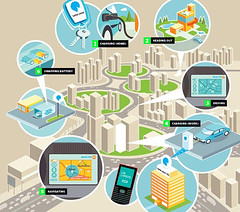Is it about sprawl, oil, carbon offsets or maintaining the asphalt nation for the next generation?

Diagram, Better Place electric car infrastructure, Wired Magazine.
There is a fascinating story in Wired about Shai Agassi's next generation asphalt nation based on electromobility. See "Driven: Shai Agassi's Audacious Plan to Put Electric Cars on the Road." And Tom Friedman wrote about it too, "While Detroit Slept" and "Texas to Tel Aviv" in the New York Times.
But if we built an electricity-based autonation, with roads everywhere, and disconnected places, would things be "better" -- other than reducing the need to consume oil (saving it for chemicals, plastics, and fertilizer, and jet engines and the military) and making right U.S. foreign policy and reducing the need for as much military?
In other words, is sprawl not a good thing generally, whether or not it is fueled by oil or electricity?
Is the Agassi proposal, where you pay as you go, and might be able to rent cars rather than own them, a way to deal with the high cost of owning a car, and therefore better than creating a walking-bicycling-transit infrastructure?
Or does having to devote so much space to roads and parking and the disconnection from place matter, regardless of how an automobile is fueled?
Certainly, the optimality issue is clear. Transit moves more people more quickly, at least in a somewhat centralized system of destinations, especially work-related trips.
--------------
Flickr image of the Harbor Freeway Interchange, Los Angeles, by g. s. george. He writes:
The Harbor Freeway Interchange is the largest and tallest freeway interchange in Southern California. This massive 5-stack interchange connects the Century Freeway (I-105) with the Harbor Freeway (I-110). Nestled between its soaring ramps is a 3-level train and bus depot. An extraordinarily clear day in Southern California. Los Angeles.
Labels: car culture and automobility, transportation planning, urban design/placemaking




0 Comments:
Post a Comment
<< Home